This xBmt was completed by a member of The Brü Club in collaboration with Brülosophy as a part of The Brü Club xBmt Series. While members who choose to participate in this series generally take inspiration from Brülosophy, the bulk of design, writing, and editing is handled by members unless otherwise specified. Articles featured on Brulosophy.com are selected by The Brü Club leadership prior to being submitted for publication. Visit The Brü Club Facebook Group for more information on this series.
Author: Matt Skillstad
Buying ingredients in bulk has several benefits, but I primarily appreciate having the flexibility to brew just about whatever I want when I have the time to do so. I usually have enough hops and grain on hand to be able to brew most styles I enjoy drinking, but yeast is the only ingredient that requires me to plan what I brew.
The relatively long shelf life of dry yeast makes it possible to stock several packs of dry yeast in various varieties, but the beers I ferment with liquid yeast often just seem “better” to me. While I prefer the ease of dry yeast, I’d be willing to invest the time and effort in planning ahead with liquid yeast if it leads to noticeably better beer. Because of this, I decided to put it to the test with some split batches before making a final decision.
I haven’t had something hoppy on tap for a while and though a nice NEIPA would hit the spot. Two yeasts commonly associated with this style are the liquid Wyeast 1318 London Ale III, said to be sourced from Boddington’s Brewery, and the dry Fermentis Safale S-04 English Ale, which is known to have originated from Whitbread Brewery. Despite the different sources, I chose to compare these strains due to how often both are recommended and to see just how different each one is.
| PURPOSE |
To evaluate the differences between a NEIPA fermented with Wyeast 1318 London Ale III yeast and the same beer fermented with Safale S-04 English Ale yeast.
| METHODS |
I formulated a fairly simple NEIPA recipe that featured some newer varieties of German hops and a significant portion of flaked oats.
Hüll & Oats
Recipe Details
| Batch Size | Boil Time | IBU | SRM | Est. OG | Est. FG | ABV |
|---|---|---|---|---|---|---|
| 6 gal | 40 min | 33.3 IBUs | 4.5 SRM | 1.072 | 1.020 | 7.0 % |
| Actuals | 1.072 | 1.012 | 8.0 % | |||
Fermentables
| Name | Amount | % |
|---|---|---|
| Pale Malt (2 Row), Rahr | 10 lbs | 66.67 |
| Oats, Flaked | 2.5 lbs | 16.67 |
| Vienna Malt (Briess) | 2.5 lbs | 16.67 |
Hops
| Name | Amount | Time | Use | Form | Alpha % |
|---|---|---|---|---|---|
| Columbus/Tomahawk/Zeus (CTZ) | 14 g | 40 min | Boil | Pellet | 12.3 |
| Hallertau Blanc | 54 g | 5 min | Aroma | Pellet | 9.7 |
| Huell Melon | 54 g | 5 min | Aroma | Pellet | 7.5 |
| Mandarina Bavaria | 37 g | 5 min | Aroma | Pellet | 10.7 |
| Hallertau Blanc | 57 g | 10 days | Dry Hop | Pellet | 9.7 |
| Huell Melon | 57 g | 10 days | Dry Hop | Pellet | 7.5 |
| Mandarina Bavaria | 57 g | 10 days | Dry Hop | Pellet | 10.7 |
Yeast
| Name | Lab | Attenuation | Temperature |
|---|---|---|---|
| Wyeast 1318 London Ale III OR Safale S-04 English Ale | 73% | 64°F - 74°F |
Download
| Download this recipe's BeerXML file |
The day before brewing, I measured out the grain & the water salts & milled the grain directly into the brew bag.
The next day, just before the kiddos’ nap time was over, I slipped out to the garage to fill the kettle with store bought RO water & plugged in my new electric immersion heater to begin slowly heating the strike water. After a couple hours of family time, the water was to strike temperature.
I added the grains to the water, gave it good stir to make sure it was well incorporated, then checked the mash temperature… 135°F/57°C. Poop! I quickly hoisted the bag out of the kettle and fired up the burner until the liquid had reached the proper strike temperature again, at which point I lowered the bag into the kettle again, gave the mash a good stir again, and checked to see that it was finally at my target 154˚F/67˚C mash temperature. Following a slightly extended 90 minute mash rest, I hoisted the grains out of the kettle and allowed them to drain as I began heating the sweet wort.
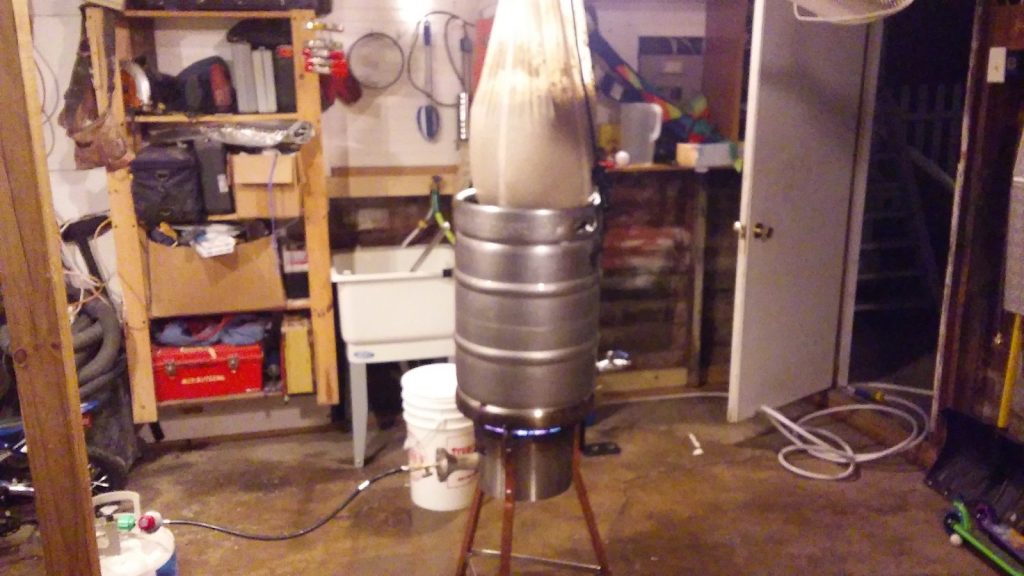
The wort was boiled for a slightly abbreviated 45 minutes with hops added at the times listed in the recipe. Once complete, I used cool RO water to top the kettle up to my desired post-boil volume of 12 gallons/45 liters, bringing the temperature to 180°F/82°C, then added the substantial hop stand charge. After about 5 minutes, I began chilling the wort to my desired pitching temperature of 63°F/19°C.
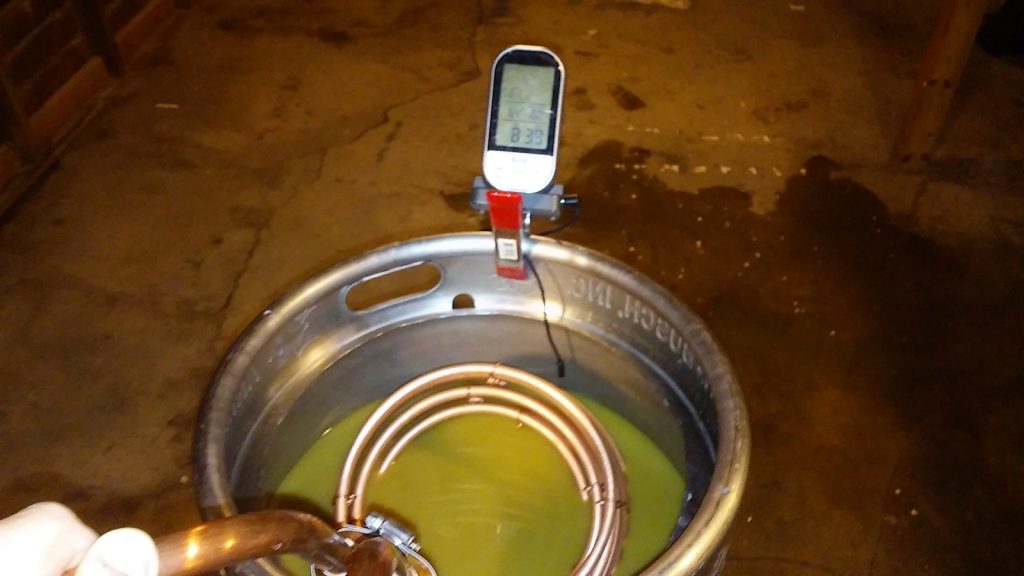
A hydrometer measurement revealed the wort hit a slightly higher OG than originally planned.
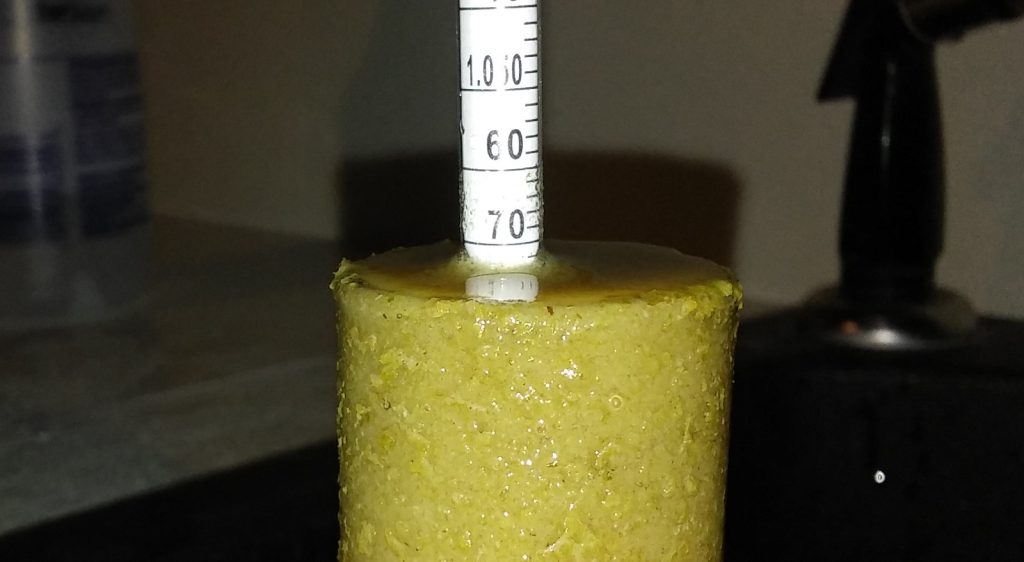
The wort was then split between two similar stainless steel bucket fermentors.
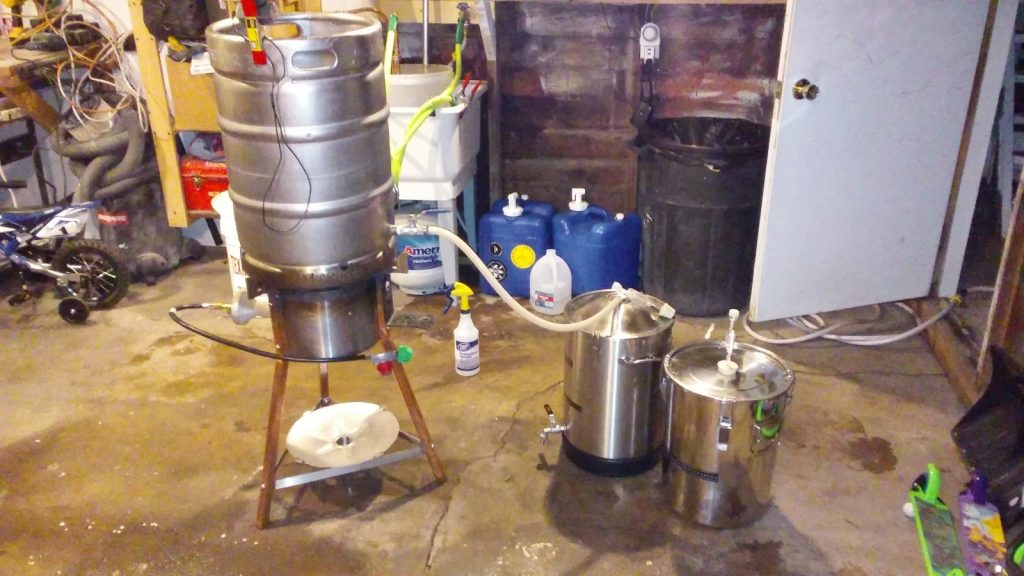
I placed the filled fermentors next to each other in my fermentation chamber controlled to 64°F/18°C before smacking the Wyeast 1318 and rehydrating the Safale S-04. After 30 minutes, the yeasts were pitched into their respective worts.
When I checked on the beers before I left for work 8 hours later, neither was showing signs of active fermentation. I checked again when I got home that evening and noticed both bubbling with similar vigor. After 3 days of fermentation, the bubbling in both airlocks had started to slow, so I added identical dry hop charges to each batch. At this point, I notice a distinct difference in the kräusen atop each beer.
The beers continued to ferment for 2 more days before I raised the temperature to 68°F/20°C to encourage complete attenuation and reduction of fermentation byproducts. After another 8 days, I took hydrometer measurements showing both beers had reached the same FG, though already looked different.
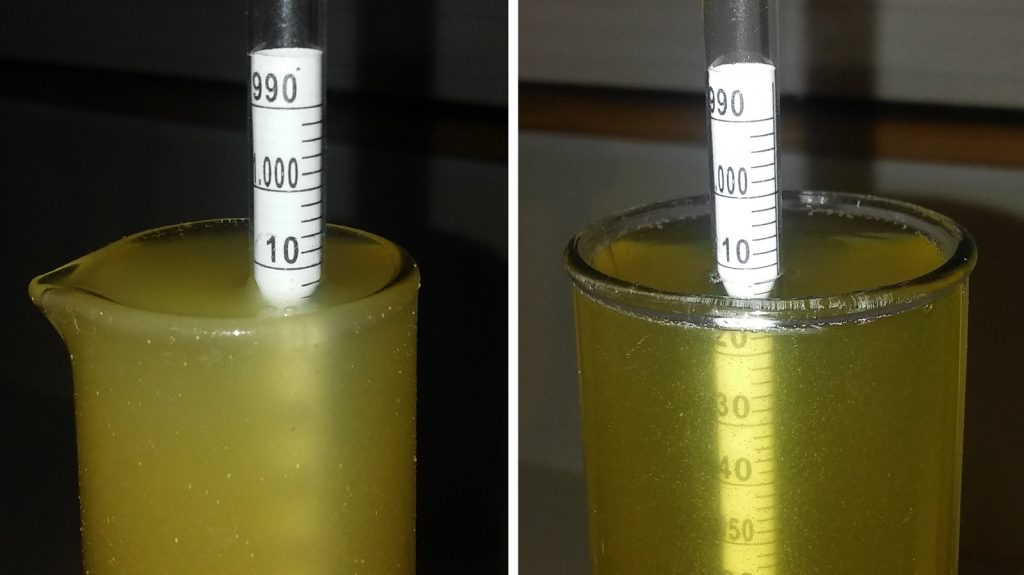
I then transferred the warm beers to CO2 purged kegs, doing my best to ensure both had similar oxygen exposure.
The filled kegs were placed on gas in my keezer to condition at serving pressure for 3 weeks, at which point they were similarly carbonated and ready to serve.
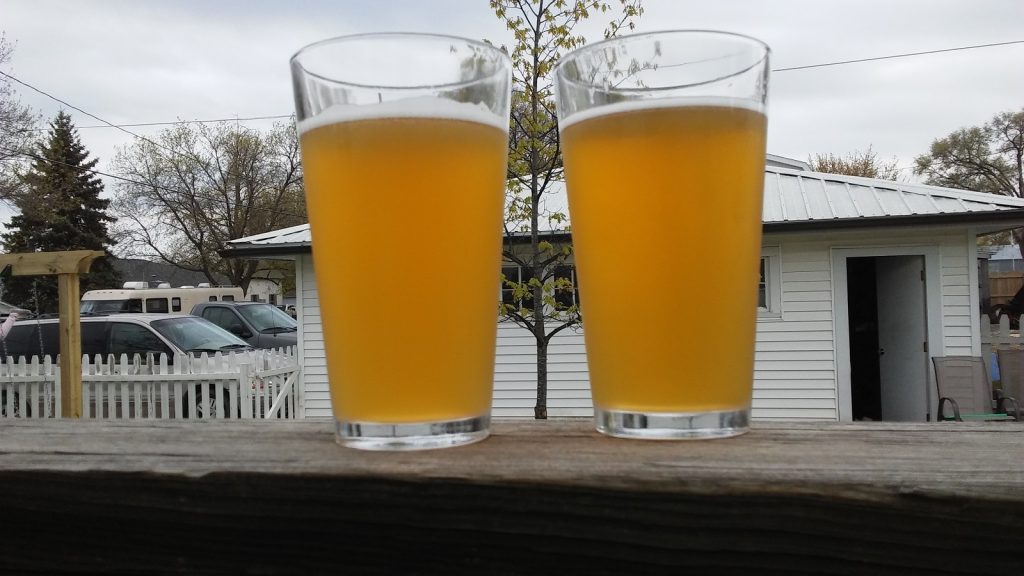
| RESULTS |
A total of 22 people of varying levels of experience participated in this xBmt. Each participant was served 1 sample of the beer fermented with Wyeast 1318 London Ale III and 2 samples of the beer fermented with Safale S-04 English Ale yeast in different colored opaque cups then asked to identify the unique sample. A total of 12 tasters (p<0.05) would have had to accurately identify the unique sample in order to reach statistical significance, yet only 8 tasters did so (p=0.460), suggesting participants in this xBmt were unable to reliably distinguish a NEIPA fermented with Wyeast 1318 London Ale III from one fermented with Safale S-04 English Ale yeast.
My Impressions: At the time of kegging, I felt these beers were noticeably different, the Wyeast 1318 version tasting brighter with a more citrusy and “juicy” hop character. It was also hazier. The S-04 version was similar, but the hops seemed slightly muted, and I perceived it as having a subtle bready/doughy tang in the finish. By data collection time, I thought the beers tasted far more similar than different. Of the 8 triangle tests I attempted, I selected the unique sample only 2 times. While both beers shared a pleasant fruity hop aroma and flavor, it was pretty soft, not quite pungent enough for what I would want in this style.
| DISCUSSION |
Yeast substitutions are a necessary part of sharing recipes because not all brewers have access to the same yeast suppliers. To me, Safale S-04 English Ale yeast seems like an odd substitute for Wyeast 1318 London Ale III, but I’ve seen it used by many trusted brewers of the NEIPA style. And the fact tasters in this xBmt were unable to reliably tell apart NEIPAs fermented with either strain suggests whatever characteristics either impart are more similar than they are different.
Deep thoughts…
In thinking about the results of this xBmt, I took a look at previous yeast comparison xBmts and noticed an interesting trend– when the yeasts being compared are from the same region and not highly expressive, the results tended to be non-significant. While the available data is inconclusive when it comes to the impact beer style has on yeast expression, it seems plausible that more flavorful styles might mask subtle fermentation characteristics that simpler styles let shine through.
The results in this xBmt seem to fit with this, as despite one being dry and the other liquid, both were of English origin. Also, the beers were fermented at a pretty low temperature, which could have minimized potential differences. Maybe close is close enough, at least in a highly characterful beer that’s not yeast driven. While I still prefer liquid yeast for various reasons, I won’t think twice to use Safale S-04 in a pinch for NEIPA when my desired strain isn’t available.
 Matt Skillstad is a happy husband to a wonderful wife (who likes his beer!) and proud father of 5 children under 7 years old from Pierce, Nebraska. He has been brewing since 2011 and, in addition to The Brü Club, is a member of the Elkhorn Valley Society of Brewers. He enjoys experimenting with his brewing in an effort to make better beer in less time with less effort. When not brewing or hanging with his family, Matt enjoys bike riding and golfing (poorly).
Matt Skillstad is a happy husband to a wonderful wife (who likes his beer!) and proud father of 5 children under 7 years old from Pierce, Nebraska. He has been brewing since 2011 and, in addition to The Brü Club, is a member of the Elkhorn Valley Society of Brewers. He enjoys experimenting with his brewing in an effort to make better beer in less time with less effort. When not brewing or hanging with his family, Matt enjoys bike riding and golfing (poorly).
If you have any thoughts about this xBmt, please do not hesitate to share in the comments section below!
Support Brülosophy In Style!
All designs are available in various colors and sizes on Amazon!
Follow Brülosophy on:
FACEBOOK | TWITTER | INSTAGRAM
If you enjoy this stuff and feel compelled to support Brulosophy.com, please check out the Support page for details on how you can very easily do so. Thanks!

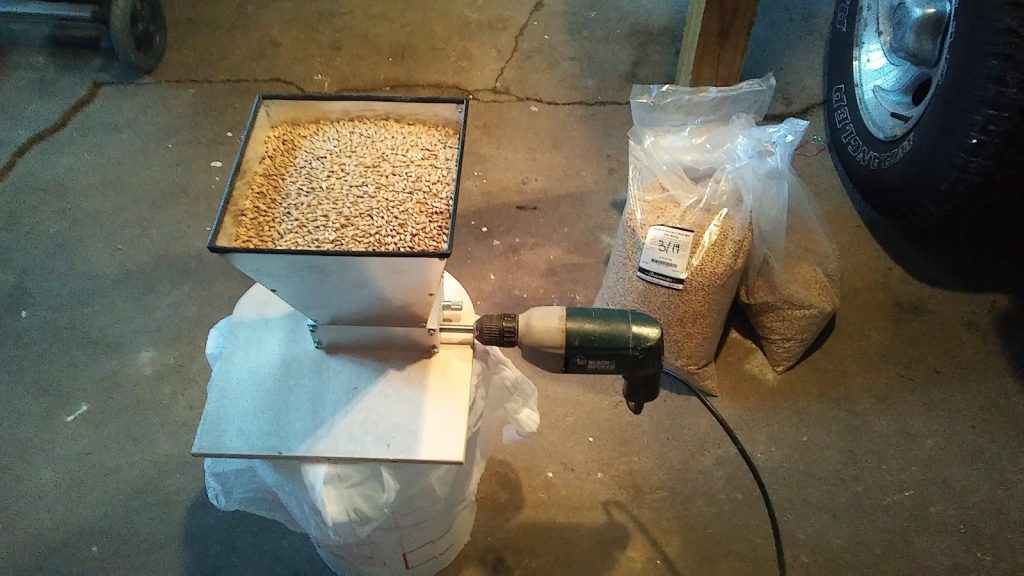
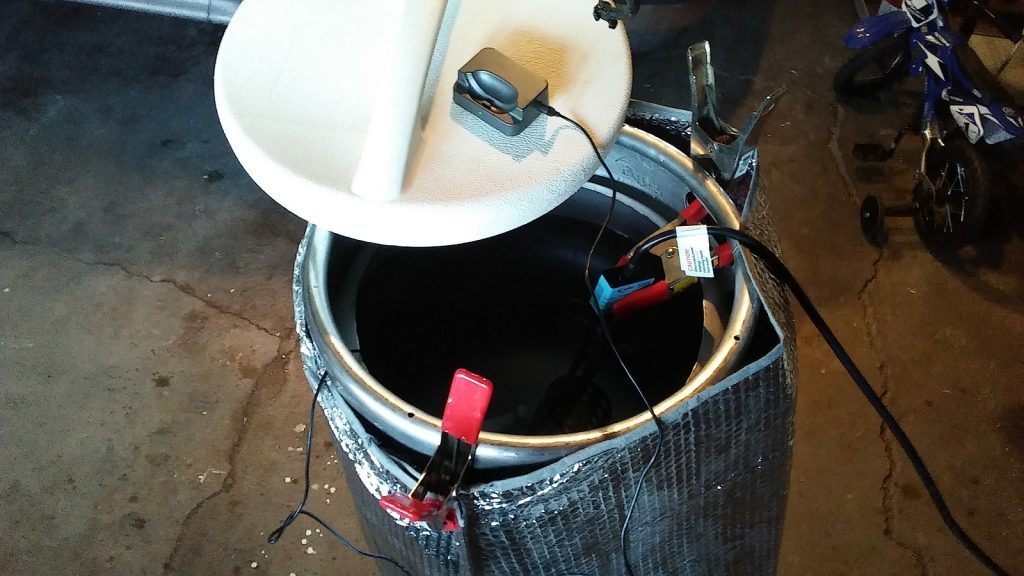
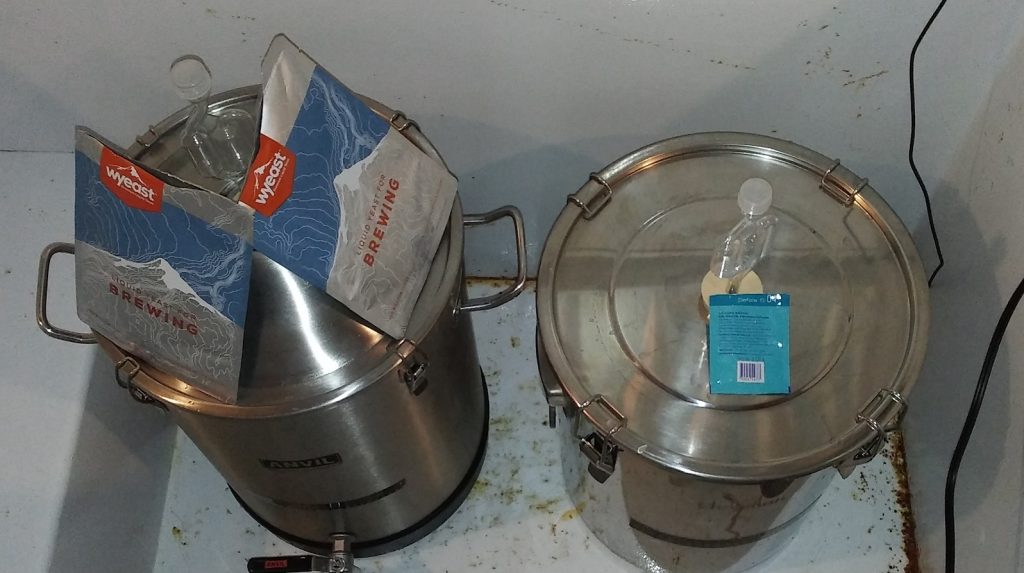
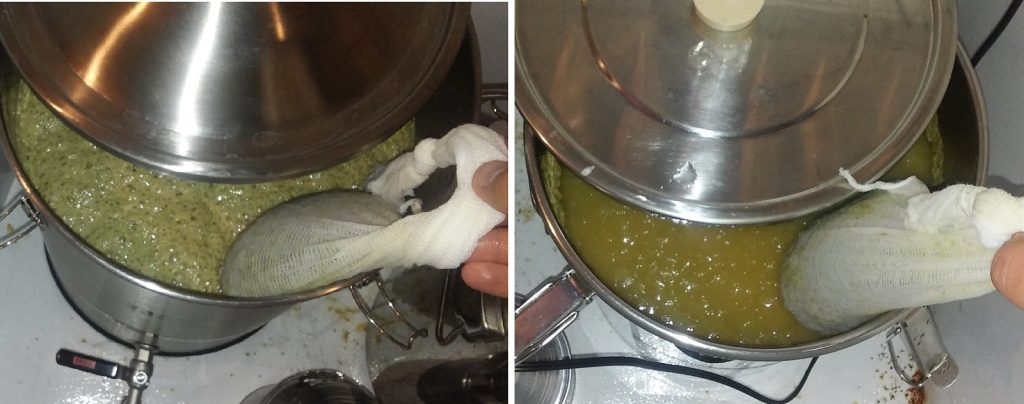
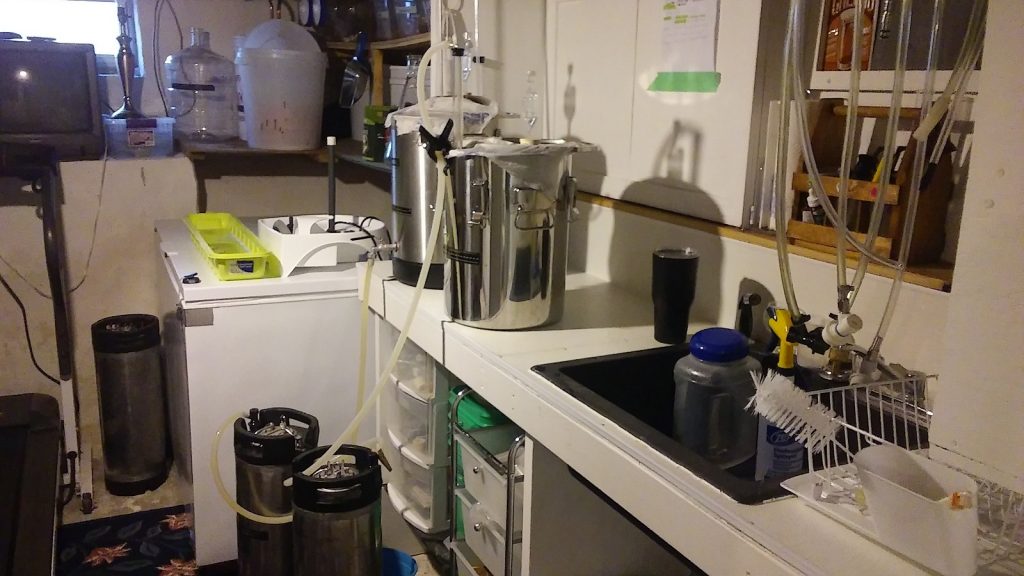











26 thoughts on “The Brü Club xBmt Series | Yeast Comparison: Wyeast 1318 London Ale III vs. Safale S-04 English Ale”
Although the internet has long believed that S-04 was from Whitbread, recent DNA sequencing suggests it is most closely related to WLP006 Bedford.
Conversely 1318 looks like it is a Whitbread strain, it’s most closely related to 1098 and WLP017 Whitbread II.
Per the infamous Treehouse thread on HBT, a splash (<10%) of T-58 helps S-04 become a bit more interesting.
To me, while interesting, this more so means that classification with respect to origin is almost meaningless–unless you are a biologist interested in origin for origin sake. We have very little idea how genetic differences (e.g. % divergence) produce the phenotypic differences affecting sensory perception of beer. Strains more closely related genetically can create different tasting beers and vice versa.
Also wanted to note, those relationships you reference only consider shared SNPs (single base differences at sites that can be compared across all strains). Undoubtably, structural variations (gene duplication, loss, rearrangement) could cause big phenotypic differences and I believe are not accounted for in either of the big yeast genome papers. [That’s not a sleight at their work, it’s not an easy thing to do!]
Even though Marshall & his brother are genetically similar I’d bet the beer they make tastes different. 🙂
I suggest you reread (or maybe read for the first time?) these papers.
“Variation in genome structure, such as polyploidy, aneuploidy, large segmental duplications, and copy-number variations (CNVs), have repeatedly been found in association with domestication and adaptation to specific niches in experimentally evolved microbes (Bergström et al., 2014, Borneman et al., 2011, Dunham et al., 2002, Dunn et al., 2012, Pavelka et al., 2010, Rancati et al., 2008, Selmecki et al., 2009, Voordeckers et al., 2015) and in association with domestication of higher organisms (Purugganan and Fuller, 2009).
Sequencing the yeast strains in their natural ploidy allowed analysis of gross chromosomal rearrangements and aneuploidies (Figure 2A). We detected a staggering 15,288 deletion and amplification events across all strains, covering on average 1.57 Mb per strain.”
From: https://www.cell.com/cell/fulltext/S0092-8674(16)31071-6
Regardless, I don’t think I agree with the crux of your comments. Phylogenetic relationships are good predictors of how similar yeast behavior (eg fermentation flavor) will be.
Luke Hoekstra and Isomerization, you both make interesting arguments based on gene research, but would either of you provide some examples of genetically similar strains that produce either similar or disimilar flavors to support your claims? (Or genetically dissimilar strains that produce similar flavors for Luke)
Lee, this is an interesting podcast about genome changes that occur during serial repitching. Not exactly what you wanted but interesting & includes good info along the lines of what you are looking for. http://masterbrewerspodcast.com/130-yeast-genome-changes-during-serial-repitching
@Lee, check out this blog post (and the referenced links and comments): http://beer.suregork.com/?p=4030
Lots of great yeast comparison info there.
Thanks for those links; I’m looking forward to checking them out!
Great article Matt! I often use S-04 in a pinch,otherwise I often use liquid yeast such as Imperial Juice, Imperial Barbarian, & London III. When I’ve fermented S-04 around 67-68 I’ve gotten pretty good expression. Next time your in a pinch give it a shot. I’m sure S-04 combined with more assertive Hop choices like Citra,Mosaic,Galaxy,Sabro,etc would help flavors and aroma come through more. What was your water chemistry like? Keep up the good work, Cheers.
Thanks Scott! I used RO water with 100ppm Ca, 75ppm S04 & 130ppm Cl.
I just kegged a NEIPA I fermented with S-04 and hopped with El Dorado, Mosaic and Motueka. Though I had no choice but to ferment warm, 70-73°F. To confirm, it is ridiculously heavy on hop aroma and flavor (and hazy like pineapple juice).
Chris may I know your hop addition amounts?
Yeah, we hop our hazys with 0.75 Mcells/ml/degP of S-04 and add 2.5-4.0 lbs/BBL of dry hops (depending on alpha acids) simultaneously. Fermented warm, 68-75 degF. Super hazy and juicy. Occasionally, we’ll use OYL-091 Hornindal Kveik, which is less hazy and adds a citrus/lemon character. No kettle hops, either way. I can personally assure you that 4.0 lbs/BBL of 19.2% alpha Vic Secret creates an undrinkably bitter beer, even without a kettle addition.
5 children under the age of 7 and still time to brew and xBmt? Matt – I applaud you!
Great article btw 🤘
I applaud his wife.
“At the time of kegging, I felt these beers were noticeably different, the Wyeast 1318 version tasting brighter with a more citrusy and “juicy” hop character”.
Then the beers were diferent, and Wyeast 1318 had better result, I think! Because 3 weeks of cold conditioning can easily fade out this style depend on hop schedule.
I too was shocked be the length of cold conditioning. Drink NEIPA fresh! 3 weeks is WAY too long IMO. Also surprised by the lack of hops after flame out, and no double dry hop. Research has shown that dry hopping during active fermentation (a la biotransformation) does indeed add to the style. Was this even an NEIPA? Nice article and experiment, though…. Not trying to trash it, just encourage critical commentary.
I had about 5.5oz at f.o. it’s just listed as 5min because that’s how long they stepped before I started chilling. The DH was added on day 3 so biotransformation had its chance. I agree that 3 weeks is not ideal, but the taste hasn’t changed much at all since being on tap about 1.5 weeks. On the craft beer & brewing podcast Henry from monkish actually talks about not releasing their beers until they are something like 30 days old or so.
Very interesting. I’m pretty surprised that the biotransformation dosen’t make a difference at the end and S-04 isn’t capable of doing it, right?
I would feel weird using dry yeast for a NEIPA. I will try a double batch with Imperial Juice on one side and the new Lallemand New England that is advertise as a dry yeast able to perform biotransformation of hops…
Hi Matt – Thanks for the test! Any Twins? Triplets? Congratulations!
I concur with others about timeline. I love to ferment fast & warm, like most commercial breweries. At 68-70F you could be transferred to a serving keg with a shortened dip tube & tasting this at 5-6 days as you dry hop. Could be all gone in 3 weeks if you have thirsty pals!
No visible fermentation activity at 8 hours? Did you use any oxygen? That’s the other thing that will speed things along with no down-side.
Hope you are not being hammered by the extreme weather! Cheers, Quentin
Thanks! Twins! It’s like brewing a 10gal batch. It’s not twice as much work but it is 2x the reward. No O2 was used. The prevailing wisdom seems to say you don’t have to (& maybe shouldn’t) aerate with dry yeast so i left the oxygen on the shelf to keep it fair. I was actually sucking ground water out of the basement with the shop vac. this am. Fortunately it’s not deep so at least the kegerator & fermenting fridge are fine. Fingers crossed for no more rain…..
Thanks for doing this xbmt, Matt and for including the table. I hadn’t thought about it until now but I’m almost 50/50 liquid to dry. Liquid for my hefe, kolsch, and stouts and dry for all of my lagers except my pilsners. However, I do make a starter when using 34/70 or s-189. So, maybe I’m technically more liquid than dry. Hmmmm.
Guys, i wanted to brew some DUVEL and wanted to rely on a pack of 1318 that has been sitting in my fridge for too long, it appears… So also practically, this is super helpful ! THANKS
I love these kind of exbeerinmenmts
Unrelated to the topic: How do you like that portless chapman fermenter compared to the anvil?
I wouldn’t recommend the Chapman. The quality is pretty rough IMO. The anvil is pretty nice though.